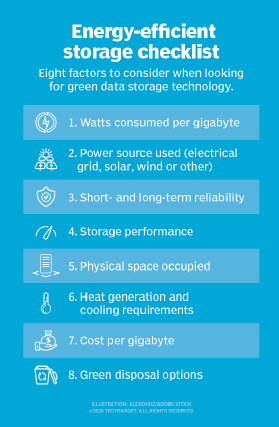green cloud
What is green cloud?
Green cloud refers to the potential environmental benefits that green IT services delivered over the internet can offer to individual companies and society as a whole. The term combines the words green -- meaning environmentally friendly -- and cloud, the traditional symbol for the internet and the shortened name for cloud computing.
There is some confusion around the meaning of the term green cloud (or green cloud computing, in its longer form). In some cases, it's used to describe the environmental benefits that result from the general movement of IT systems to the cloud. For example, the cloud consolidates the total number of data centers and better supports a remote workforce in some organizations, leading to lower resource utilization and the overall reduction of greenhouse gas emissions.
However, it would be more accurate to describe these characteristics as the green benefits of cloud computing, rather than a green cloud. Even with such general benefits, individual data center operators might make little effort to reduce their carbon footprint. But if so, that stance is likely to change, given the projected growth of cloud computing and increasing pressure to address the environmental impact of data centers -- trends that make development of green cloud environments more pressing.
According to a European Commission study on energy-efficient cloud computing technologies published in 2020, data centers accounted for 2.7% of the European Union's electricity demand in 2018, and this is expected to reach 3.21% by 2030 if demand continues its current trajectory. The U.S. Department of Energy has said data centers account for about 2% of the country's total electricity consumption, and the International Energy Agency estimated in a September 2022 report that up to 1.3% of worldwide electricity usage in 2021 was in data centers.
This article is part of
ESG strategy and management guide for businesses
By all those measures, data centers are consuming a significant amount of energy overall, and this usage will only accelerate as digital transformation initiatives in companies further expand and data center growth continues. In particular, cloud data centers often are behemoth facilities, housing thousands of servers, numerous racks of storage devices, miles of networks and the peripheral infrastructure necessary to keep everything running. To address the environmental challenges associated with these facilities, cloud service providers have been adopting green cloud practices to varying degrees, more so in areas under public scrutiny.
In this sense, green cloud computing refers to the steps that service providers are taking to improve the environmental profiles of their data centers by implementing green computing approaches. The resulting green clouds can also contribute to broader environmental, social and governance (ESG) programs at the cloud vendors themselves and companies that use their services. Greener IT is a common component of corporate ESG initiatives, which aim to improve the environmental and social impact of organizations and ensure that their business practices are ethical and fair.
How does green cloud computing work?
Cloud service providers typically employ multiple strategies to attain greener data centers. These efforts target efficiency improvements in one or more of the following areas:
- Energy sources. The provider uses renewable energy as much as possible to power its data centers. This often includes wind or solar energy, along with large battery banks for storing the collected energy. Some providers use renewable energy credits (RECs) to offset their carbon footprint, giving them license to claim that their data centers use 100% renewable energy. However, RECs are not the same as eliminating the use of fossil fuels.
- Facility. The provider takes measures to use energy more efficiently in its data centers. For example, a provider might locate a data center in a cold climate, underground or even on the ocean floor. The provider might also find ways to apply the excess heat generated in the data centers, such as using it to warm nearby buildings. Additionally, providers might rely on machine learning or artificial intelligence technologies to monitor and optimize energy usage. Modifying the data center floor layout to improve air circulation through the use of hot and cold aisles or implementing water cooling systems to handle equipment-generated heat are other strategies.
- Infrastructure. The provider optimizes the hardware and software infrastructure. For instance, a provider might deploy hardware that consumes less energy or use strategies such as dynamic voltage and frequency scaling to reduce power consumption. The provider might also maximize resource utilization to reduce the number of servers and storage devices -- for example, by implementing virtualization technology or software-defined infrastructure.
- Workflow. The provider uses multiple strategies to optimize IT workflows at every level. This might include shifting workloads to different times, modifying applications to reduce network traffic, optimizing storage and server caches, automating routine tasks or taking any number of other steps to reduce energy usage.
Read more on ESG strategy and management
5 ways organizations can address the social factors of ESG
A timeline and history of ESG investing, rules and practices
ESG audit checklist: 6 steps for success
ESG materiality assessments: What CIOs, others need to know
ESG metrics: Tips and examples for measuring ESG performance
18 sustainability management software providers to consider
As examples of green cloud practices by top cloud platform vendors, Amazon Web Services (AWS) and Microsoft have both said they plan to use 100% renewable energy in their data centers by 2025. Google has said it achieved that in its Google Cloud facilities in 2017 and is aiming to run them all on carbon-free energy sources by 2030. Microsoft is working to be carbon-negative by that year, while AWS is looking to reach net-zero carbon usage by 2040.

As data continues to proliferate, storage systems also play an increasingly important role in efforts to boost energy efficiency, including in cloud data centers. Strategies for implementing greener approaches to data storage include evaluating the energy requirements of different storage devices before purchases, shutting down installed devices when they aren't in use, and identifying and deleting so-called dark data that isn't being used.
To help address storage-related energy issues, the Storage Networking Industry Association (SNIA) operates the Green Storage Initiative, which is "dedicated to advancing energy efficiency and conservation in all networked storage technologies and minimizing the environmental impact of data storage operations." As part of this effort, SNIA offers the Emerald Program, a collection of resources for measuring storage power usage and efficiency as well as for conserving energy in enterprise storage environments.
Finally, because the color green is associated with paper money, the label green cloud has sometimes been used to describe the cost-efficiency of a cloud computing initiative, although this is relatively rare.
See also: green data center, green networking, green software, green storage, greenwashing and sustainability risk management.








